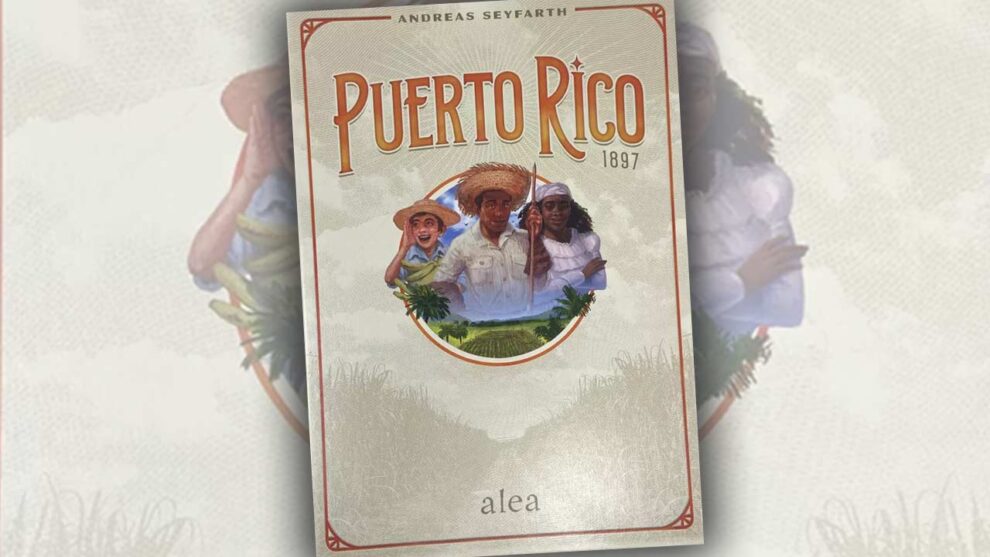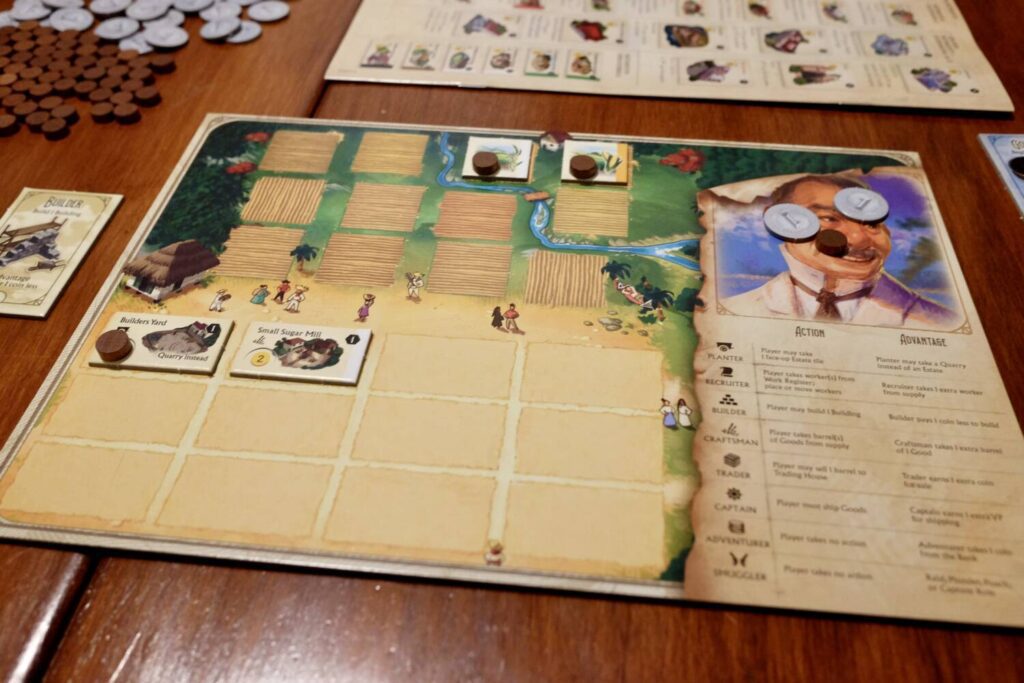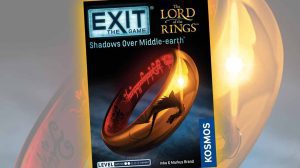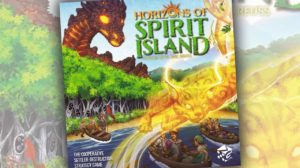Disclosure: Meeple Mountain received a free copy of this product in exchange for an honest, unbiased review. This review is not intended to be an endorsement.
Puerto Rico was first released in 2002, and is one of my favorite board games. I’m hardly alone in that. Andreas Seyfarth’s masterful design was the #1-rated board game on BoardGameGeek for five years in the mid-2000s, and it still sits in the top 50 today. It directly inspired Tom Lehmann to design Race for the Galaxy, a fraternal twin of a game and another of the all-time greats. Puerto Rico’s system is so good that even a knock-off constitutes one of the best games ever made.
Despite its considerable laurels, Puerto Rico has fallen out of favor in recent years, particularly as the hobby has (slowly) grown more inclusive. Like many Euro games, particularly of that time, Puerto Rico’s setting prominently features colonialism. Unlike many games of that era, in Puerto Rico, it is hard to ignore. As cultural sensitivities shifted and awareness increased, people grew uncomfortable with playing as Spanish colonial governors assigning brown laborer discs to work in their fields.
In 2022, Alea and Ravensburger announced Puerto Rico 1897, an updated version of the game. The title refers to the year in which Puerto Rico was granted a level of autonomy by the Spanish government. After 400 years of colonial status, Puerto Ricans could form their own parliament, which, among other things, allowed them to make their own decisions about imports and tariffs. Calling this new edition Puerto Rico 1897 was an indicator from both publishers that they were taking seriously the business of giving one of the greatest games ever made a facelift.
When it came out in the winter of 2022, the launch went perfectly, there were no product issues, and people have been enjoying Puerto Rico in its new and improved form ever since. (None of that is true.)

Agriculture in the 19th Century Caribbean
The goal of Puerto Rico 1897 is to gain points through a combination of agriculture, commerce, and civic construction. If you’re already familiar with Puerto Rico, you can skip this section. Absolutely nothing about the gameplay has changed. If you aren’t, this is going to sound fairly dry, but I promise that Puerto Rico 1897 is one of the most rewarding Euro games out there.
Each round, each player spends their turn choosing one of the roles from the center of the table, which sets off a particular action. The best way to get a sense of the game is to go through each of those roles, which I’ll do in brief:
The Planter allows players to add Estate Tiles to the upper half of their player boards. Estate Tiles are half of what you need to start producing most agricultural goods.
The Builder gives everyone access to the Building Tiles, which go in the City portion of your player board. Buildings cost varying amounts of money, they all score you points at the end of the game, and the majority of them give you a bonus ability for the rest of the game.
The Recruiter provides players with workers, which are then placed on empty worker slots around your Estate. An Estate Tile is worthless without a worker on it, and the same is true of Buildings.
The Craftsman triggers agricultural production for everyone. For every Estate Tile and corresponding Building with a worker on it, you can produce one barrel of that good. If I don’t have a Coffee Roaster to process the beans, it doesn’t matter if my employees are out in the coffee fields harvesting. It’ll all go to waste.
The Trader lets all players trade a good in exchange for money. The more difficult the good is to produce—in real world terms, the less common the good is—the more money you’ll get for it.
The Captain lets players ship large quantities of produced goods out to sea, hopefully earning vast sums of Victory Point Chips in the process.
The final role, the Adventurer, lets you take a coin from the bank.
I cannot choose a role that has already been taken this round, and any role tokens that are left at the end of a given round receive one coin to incentivize picking them in the next one. The game continues until one of three things happens: there are no more workers, there are no more Victory Point Chips, or any player has filled their City spaces.
Truth in Advertising
I’ve lied to you by omission here. I’ve made Puerto Rico 1897 sound both dry and, and this is the big lie, pleasant. To the contrary, Puerto Rico 1897 is a vicious game, full of sabotage. There’s significantly more nuance to all of the actions. For one thing, you’re not choosing a role and an action for yourself. You’re choosing it for everybody. If I pick the builder, I get to construct something first, but everyone else also gets to have a conversation with their city planner.
On top of that, there are timing considerations to take into account for every role. If you notice one or two players are low on money, that’s a good time to be the Builder. If you’re the only one with significant goods, you might as well choose the Captain. The Trading House, which governs the trading action, only has room for one of each type of good. If you’ve got the same high-yield crop as your opponent, you might as well choose the Trader and stick it to ‘em.
More perhaps than any other game I love besides Barrage, Puerto Rico 1897 constitutes an endless series of traded profanities. Because the design is zero luck, and because you can account for potential future issues with good play, it never becomes frustrating, even if it can be frustrating. You spend your turns planning what you want to do, and what you think other people will do, and setting yourself up to better take advantage of what they were going to do anyway. You can’t get mad when people out-play you, because, well, you let them.
Mistakes Were Made
There were some issues with the initial print run of Puerto Rico 1897. Tiles were provided in erroneous quantities, and the rulebook listed two of the building tiles as having the same effect. Ravensburger received an enormous amount of negative feedback for that, as is right. Well, I say “as is right.” To be honest, I think the negative feedback was out of proportion, and in certain cases provided cover to indirectly express some darker feelings related to this particular edition. I’ll save my thoughts on that for another time.
Ravensburger, as far as I’m concerned, acquitted themselves admirably. Not only did they take the necessary steps to fix production going forward, they completely removed the first print-run from distributors, costing themselves an incredible amount of money in the process. They fixed the mistakes and took advantage of the do-over to address some other issues. Building tiles in Puerto Rico 1897 were originally going to be free of text, which is a horrible idea. Even longtime players still need to refer to the text on tiles to remember exactly what everything does. There is now text on the tiles, and a player aid was added to the reverse side of the manual.
Puerto Rico 1897 marks the triumphant return of one of the greats, with much-needed adjustments to its setting. Maybe this re-theme seems silly to you, but I can assure you that it isn’t. All the evidence I need: My best friend, who considers Puerto Rico her absolute favorite game, married into a Puerto Rican family. She and her husband never play it, because it makes them both uncomfortable. Now they can. This is no longer one of the thousands of games in which you explicitly and uncritically take on the role of genocidal oppressors. If that sounds like overstatement to you, I’m happy to recommend some books you can read. If it doesn’t, have I got a game for you.













Add Comment